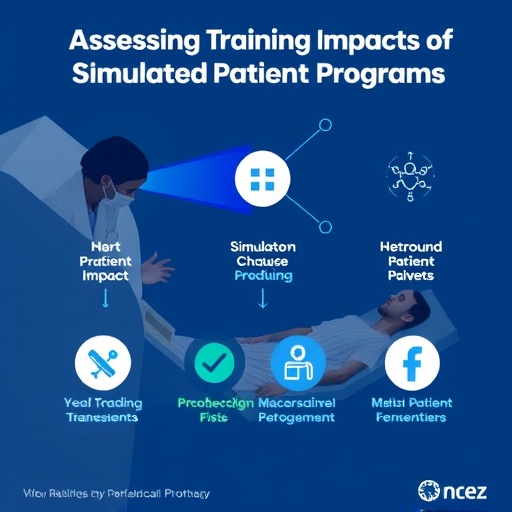In the rapidly evolving landscape of medical education, the incorporation of innovative teaching methods has become a focal point for educators and policymakers alike. One such method that has garnered significant attention is the use of simulated patient (SP) programs, particularly in the context of Obstetrics and Gynaecology (O&G) education. Recent findings from a study conducted by Kumar, Rizk, Al Jufairi, and colleagues provide valuable insights into the efficacy and perception of these programs within the Gulf Cooperation Council (GCC) region.
The study, which utilizes a mixed-method approach, stands out for its comprehensive evaluation of both the educational impact and stakeholders’ perspectives. By implementing both quantitative and qualitative research methods, the authors aimed to paint a more holistic picture of simulated patient programs. The study surveyed participants from various medical institutions, examining various facets of training effectiveness, including knowledge retention, clinical skills enhancement, and changes in learner attitudes.
Understanding the training effectiveness of simulated patient programs is essential, especially for disciplines such as O&G, where patient interactions can be complex and sensitive. The integration of simulation in medical training allows students to engage in realistic clinical scenarios without the risks associated with treating actual patients. This study highlights the pivotal role that these programs play in bridging the gap between theoretical knowledge and practical application.
In the context of the GCC, where medical education is continuously evolving to meet international standards, the findings underscore a significant shift towards the acceptance and implementation of simulation-based learning. Stakeholders involved in the study expressed varying perceptions about the effectiveness of these programs. Some educators noted remarkable improvements in students’ confidence and clinical competencies after participating in SP sessions, indicating a positive correlation between simulated experiences and professional preparedness.
Conversely, certain challenges were identified, particularly regarding resource allocation and training methods for educators themselves. The study reveals that while students appreciate the benefits of SP programs, educators’ engagement and expertise in facilitation significantly influence the overall effectiveness of these training sessions. This highlights the need for ongoing professional development for faculty members who lead such initiatives.
The significance of stakeholder perceptions cannot be understated, as they influence curriculum development and the sustainability of educational programs. The insights gathered from both students and faculty provide a roadmap for institutions looking to enhance their educational offerings. When stakeholders feel their opinions are valued, they are more likely to invest in the programs and contribute to their success.
Moreover, the implications of this study extend beyond the GCC region, providing a framework that other global institutions can utilize when considering the implementation of simulated patient programs. With increasing focus on experiential learning, this research could serve as a cornerstone for future studies aimed at evaluating the effectiveness of simulation in medical education worldwide.
Another critical aspect illuminated by the study is the necessity for robust assessment frameworks that measure not only educational outcomes but also the long-term impacts of simulation-based training on clinical practice. As the medical field is dynamic and ever-changing, a continuous feedback loop that incorporates evaluations from recent graduates can further enhance these educational programs.
Within the realm of medical education, collaboration is essential for innovation. The study advocated for partnerships between academic institutions, healthcare providers, and policy-making bodies. By fostering an environment that encourages collaboration, the medical education sector within the GCC can leverage resources effectively and enhance the overall quality of training provided to future healthcare professionals.
Additionally, it is vital to recognize the emotional and psychological aspects of learning in high-stakes environments such as O&G. The incorporation of scenarios involving simulated patients can help students navigate the complexities of patient interactions, including those that are emotionally charged. This aspect of training not only prepares students for clinical excellence but also fosters empathy and understanding, which are integral to the practice of medicine.
As this study highlights the various dimensions of simulated patient programs, it also calls for a reevaluation of traditional teaching methodologies in medical education. Aspects such as passive learning through lectures should be balanced with active participation in simulated environments. This shift could lead to more engaged learners who are better prepared to transition into their professional roles while emphasizing the importance of patient-centered care.
Looking ahead, the challenges associated with these programs should not deter educational institutions from pursuing simulation-based methodologies. Instead, institutions must view them as opportunities for growth and improvement. By addressing concerns related to funding, faculty training, and resource allocation, medical schools can create a sustainable model for integrating simulation into their curricula.
It is evident that the exploration of simulated patient programs is not only timely but essential in enhancing the quality of medical education. As this research illustrates, investing in such programs could yield dividends in producing highly skilled, confident, and empathetic healthcare professionals who are equipped to meet the demands of modern medicine.
In conclusion, Kumar, Rizk, Al Jufairi, and their team’s findings present a compelling case for the validation of simulated patient programs in Obstetrics and Gynaecology education. Their research not only reinforces the importance of innovative teaching methods but also sets the stage for future inquiries into the effectiveness of simulation-based learning across various medical disciplines. By embracing these forward-thinking approaches, the medical education community can continue to evolve and meet the needs of tomorrow’s healthcare environment.
Subject of Research: The efficacy and perception of simulated patient programs in Obstetrics and Gynaecology education within the GCC.
Article Title: Validating simulated patient programmes in Obstetrics and Gynaecology education: a mixed-method study on training effectiveness and stakeholder perceptions in the GCC.
Article References:
Kumar, A.P., Rizk, D., Al Jufairi, Z. et al. Validating simulated patient programmes in Obstetrics and Gynaecology education: a mixed-method study on training effectiveness and stakeholder perceptions in the GCC. BMC Med Educ 25, 1439 (2025). https://doi.org/10.1186/s12909-025-07912-2
Image Credits: AI Generated
DOI: 10.1186/s12909-025-07912-2
Keywords: Simulated patient programs, medical education, Obstetrics and Gynaecology, training effectiveness, stakeholder perceptions, Gulf Cooperation Council, experiential learning.




